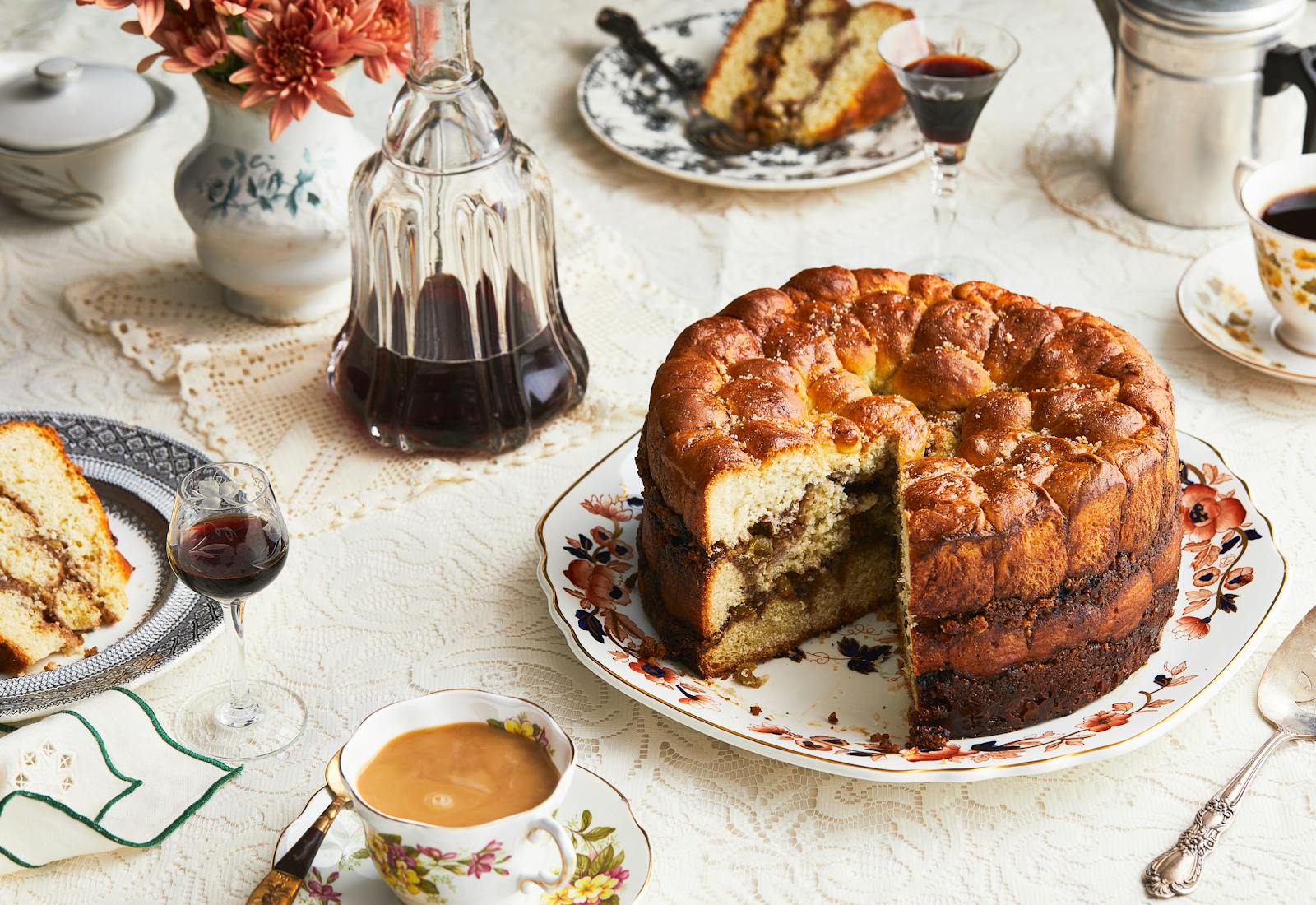Shared by Yonit Naftali


In food writer Yonit Naftali’s family, Jewish holidays have their own special desserts. For Passover there’s a torte with nuts that’s layered with chocolate ganache. Come Shavuot in spring, there are semolina and cheese dumplings, for Hanukkah, it’s yeast doughnuts, and on Purim, walnuts and poppyseeds are tucked into fluden and beigli for Mishloach Manot (holiday care packages).
In the fall, Simchat Torah is marked with aranygaluska, a traditional Hungarian dessert consisting of balls of yeasted dough rolled in sugar, ground walnuts, and golden raisins. While aranygaluska literally translates to “golden dumplings,” the Naftali family has their own nickname for it, owing to its regal appearance: crown cake. “The crown shape resembles the crown of the Torah that is paraded around the synagogue on Simchat Torah,” Yonit explains. Her mother Eva still makes it in a beautiful pan she bought for her mother with her very first paycheck in the 1970s.
All of these holiday recipes come from her mother’s family who trace their roots to Oradea in Transylvania. After the Holocaust, Yonit’s grandmother Paula had nothing; much of her family perished in Auschwitz and one of the few things she could cling to were her late mother’s recipes, which she continued to make and pass down to her daughter Eva. “It’s the only thing [my mother] has that is left from her family, from her tradition,” Yonit says.
Cook’s note: In Yonit’s family, this dessert is served with a homemade cherry liqueur, but it also pairs well with tea or coffee to balance the sweetness.
Read more about Yonit Naftali in “A Shavuot Feast Marks the Start of Summer for This Family” and in our cookbook “The Jewish Holiday Table: A World of Recipes, Traditions & Stories to Celebrate All Year Long.”
Make the dough: In a small bowl, add the yeast, 3 tablespoons of lukewarm water, and ½ tablespoon of the sugar. Mix until the yeast has dissolved, then set aside for 10 minutes or until the mixture has doubled in size.
Sift the flour into a separate, medium-sized bowl and add the remaining sugar, lemon zest, kosher salt, and vanilla sugar if using. Mix to combine, using a wooden spoon. If you are using vanilla extract, add to the egg yolks and mix. Add the yeast mixture and egg yolks to the bowl and mix to combine. Mix until the mixture has primarily pea sized crumbles of dough.
Add ⅓ cup of lukewarm water and knead the dough by hand until the water is absorbed, then add another ⅓ cup of water. Knead the dough and repeat with the remaining ⅓ cup water. At this point, the dough will be soft and a bit sticky. Cover the bowl with a kitchen towel and place in a warm place for one hour until the dough doubles in size.
Uncover the dough, add the oil and remove from the bowl. Knead the dough by hand for about 10 minutes, until it is soft, airy, and shiny. Oil the bowl and place the dough back into the bowl, covering it with a towel. Set the bowl aside in a warm place for about 30 to 40 minutes until the dough doubles in size again.
Meanwhile, prepare the topping: In a small bowl, mix the ground walnuts, sugar, vanilla sugar or extract and raisins until combined. Set aside.
Grease an 8” round cake pan with 5” sides with 1 tablespoon of vegetable oil. Sprinkle about 2 tablespoons of sugar evenly over the bottom and sides of the pan.
Uncover the dough. Weigh the dough and divide into 3 equal portions. Take one portion (⅓) of the dough and begin to form the bottom layer of cake.
Use a teaspoon and dip it into a bowl filled with the 1/2 cup of oil. Fill the oiled teaspoon with dough and drop the oiled ball of dough into the baking pan. Repeat until you have used the whole portion of dough, dipping the teaspoon into the bowl of oil in between each piece of dough.
Arrange the small dough balls very close to each other in concentric circles starting from the outer border of the pan into the center. Continue until you have used ⅓ of the dough and the bottom of the pan is covered in small, teaspoon sized balls of dough. Sprinkle the dough with half of the walnut topping.
Use a second portion of the dough to create another layer of oiled dough balls, placing them on top of the walnut topping. Cover with the rest of the walnut topping, then use the last portion of dough to create one last layer of dough balls. At this point, you should have three layers of dough balls separated by two layers of walnut filling.
Place a towel over the cake pan and set it aside for 30 minutes, letting it rise.
Preheat the oven to 350 degrees. Uncover the pan and brush the top layer of the cake with beaten egg. Sprinkle with sugar. Bake the cake for 35 minutes and check: insert a kitchen knife into the center of the cake, if it comes out clean (with little crumbs) the cake is ready; if it’s wet, bake 5 more minutes and recheck.
Remove the cake from the oven and let it cool for about 10 minutes. Use a butter knife to separate the edges of the cake from the pan. Cover the pan with a flat and wide plate. Hold the pan and the plate together with your hands using a kitchen towel and flip the cake over onto the plate. Invert the cake back onto another plate and serve.